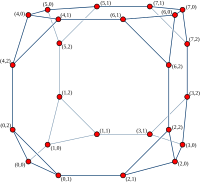Cube-connected cycles

Imagine you have a bunch of toy cubes that you can connect to each other in different ways. You can connect each cube to its neighbor by its sides, just like how you build with blocks.
Now let's say that you stack these cubes in a way where each cube is connected to its six neighboring cubes. This stacking creates a three-dimensional cube, also known as a "hypercube."
But that's not all! Let's connect the cubes in a different way. Instead of just connecting each cube to its six neighbors, let's connect each cube to all of the other cubes that are distance 2 away. This means that each cube will be connected to 12 other cubes, creating more connections and making our hypercube more complex.
We can keep going and connecting our cubes in a different way, this time connecting each cube to all of the other cubes that are distance 3 away. This time, each cube will be connected to 8 other cubes, creating more connections again.
The cube-connected cycle is the result of connecting our cubes in this specific way. We can think of it as a graph where each vertex (representing a cube) is connected to all of the other vertices that are a certain distance away, creating a sort of "cycle" of connections.
Overall, the cube-connected cycle is a specific way of connecting cubes together to create a more complex structure with lots of connections between the cubes.
Now let's say that you stack these cubes in a way where each cube is connected to its six neighboring cubes. This stacking creates a three-dimensional cube, also known as a "hypercube."
But that's not all! Let's connect the cubes in a different way. Instead of just connecting each cube to its six neighbors, let's connect each cube to all of the other cubes that are distance 2 away. This means that each cube will be connected to 12 other cubes, creating more connections and making our hypercube more complex.
We can keep going and connecting our cubes in a different way, this time connecting each cube to all of the other cubes that are distance 3 away. This time, each cube will be connected to 8 other cubes, creating more connections again.
The cube-connected cycle is the result of connecting our cubes in this specific way. We can think of it as a graph where each vertex (representing a cube) is connected to all of the other vertices that are a certain distance away, creating a sort of "cycle" of connections.
Overall, the cube-connected cycle is a specific way of connecting cubes together to create a more complex structure with lots of connections between the cubes.
